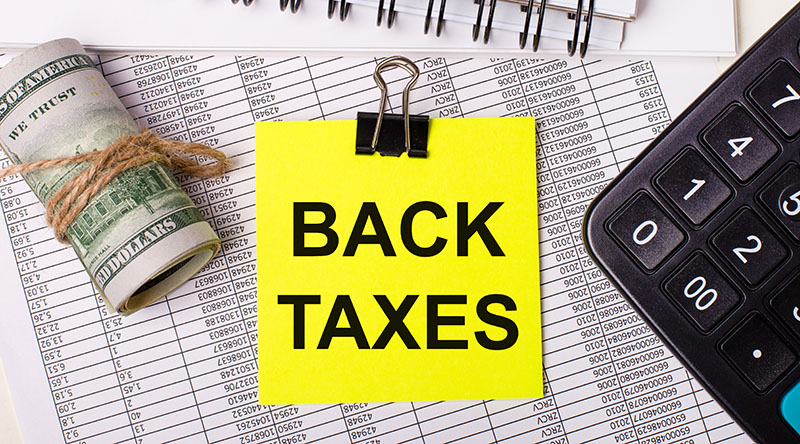Back Taxes: How to File and What You Need to Know
November, 12 2021 by Jean Lee Scherkey, EA
Growing up, many of us had that special aunt or uncle that taught us how to play cards. For me, it was my Uncle Ben. During summer evenings, just after he closed his pizzeria for the evening, my Uncle Ben would gather the nieces and nephews together and teach us how to play euchre and poker. Interspersed between laughter, root beer, and pizza, valuable life lessons were learned. One such lesson was a card laid is a card played. Even if you have not filed one or more returns, all is not lost. You can and should still prepare and submit a return, even if it is a tad or more late.
Taxpayers are required to file a tax return if their income meets a certain level that is based on their filing status. Once the return is filed, the IRS will assess any tax that is due. This is true no matter if the return is filed by the due date (usually April 15 of the following year) or later. Unfortunately, when a taxpayer fails to file their return, the IRS does not fold their hand, shrug their shoulders, and wish for better luck next year. Sooner or later, the taxman will come knocking with his own calling card, usually in the form of a notice of tax due. Now, you may be thinking that this notice of tax due is just a bluff to get you to send money. After all, if you never filed a tax return, how can the IRS possibly assess any tax? Well, the IRS has an Ace or two up its sleeve just waiting to be played.
When a taxpayer has a filing requirement and does not file a return, eventually, the IRS steps in and makes a tax assessment on behalf of the taxpayer. The assessment is based on the information they received from third parties such as employers, banks, brokerages, and merchants such as eBay, Amazon, or Etsy. The IRS will take the income information they received and prepare what is known as a substitute for return or SFR.
If you are thinking, “Fantabulous, the IRS just saved me from preparing my own return!” you may want to hold off uncorking the champagne. When preparing a substitute for return, the IRS will either use the Single filing status or Married Filing Separate filing status if the taxpayer is married. The IRS will not use the more advantageous Married Filing Joint status because filing jointly is considered an election. Got a couple of darling little tax deductions at home? Well, the IRS will not be adding them to the return either. And that includes the tax credits that are associated with your favorite rug rats, like the Child Tax Credit. Surely a substitute for return will take into consideration your itemized deductions, right? Add another tear to that root beer of yours because typically, the IRS will incorporate the standard deduction on a substitute for return. Once the substitute for return is prepared, the IRS will issue Letter 2566, Proposed Individual Income Tax Assessment, which notifies the taxpayer of the substitute for return prepared on their behalf. From the date listed on the letter, the taxpayer will have 30 days to:
- Submit a prepared Form 1040;
- Sign and date the included “Consent to Assessment and Collections” form if the taxpayer agrees with the substitute for return;
- Provide a statement explaining to the IRS why a return is not required; or
- File an appeal
If the taxpayer does not respond to Letter 2566, the IRS will mail the taxpayer CP3219, Notice of Deficiency. Once this notice is received, the taxpayer has 90 days to petition Tax Court if they disagree with the proposed tax assessed on the substitute for return. If the taxpayer does not petition Tax Court within the 90-day period, the IRS will assess the tax calculated on the substitute for return and send the taxpayer Notice CP22, which is a bill for the tax due.
Many taxpayers who have not filed their returns discover that the IRS already laid and played their cards by preparing a substitute for return and assessing tax due. However, this does not mean that lady luck has left the building. You still have a couple of cards to play that may help your tax situation.
Often the substitute for return the IRS prepares has a much higher tax liability than the taxpayer’s actual liability would have been had they filed their own return. This is because the IRS does not take into consideration that a taxpayer may qualify for a more beneficial filing status other than Single or Married Filing Separate, have enough qualified expenses to claim itemized deductions, or have kiddos which qualify the taxpayer for the Child Tax Credit, Child and Dependent Care Credit, or even the Earned Income Tax Credit. It may be in the taxpayer’s best interest to prepare and file their own tax return for the year in question, claiming the qualified expenses, deductions, elections, and credits they can rightfully take. This may result in lower tax due, and maybe even a refund you can take to Vegas! (Keep in mind that if the return is submitted too late, the statute of limitations for filing a claim for refund may have already passed. Once the time to claim a refund has lapsed, the refund is considered forfeited and may not be claimed by the taxpayer.) Here is an example.
Cole Diamond is a California history buff who participates in California Gold Rush reenactment shows. To fund his hobby, Cole heavily invests in the stock market. In February 2016, Cole prepared and e-filed his 2015 individual return, or so he thought. When he hit the submit button, his computer had a momentary “hiccup” and did not transmit the return. Unfortunately, Cole did not double-check to make sure his return successfully e-filed. Since the return Cole prepared had a zero balance and no refund, it never occurred to Cole that something could be awry.
In May 2019, the IRS prepared a 2015 substitute for return using the wage and income information reported to the IRS from third parties. The only income reported to the IRS was a 1099-B, Proceeds from Broker and Barter Exchange Transactions from Scottrade (now known as TD Ameritrade), showing gross proceeds from the sale of stock totaling $200,000. The 2015 substitute for return showed a balance due of $47,433. When penalties and interest were added to the amount due, Cole owed $54,297!
Once he realized what had happened, Cole recreated his 2015 return and submitted it to the IRS. When taking into consideration the cost basis on the stocks that were sold, Cole’s short-term capital gain was $45,000. Furthermore, he had $42,033 in qualified itemized deductions. Taking into account his itemized deductions, Cole had a zero-balance due on his return! The IRS verified Cole’s stock basis and itemized deductions, and accepted the return he filed. His 2015 account was adjusted and now shows a $0 balance due.
Another reason why it may be a good idea to file a back-year return is to start the statute of limitations on tax assessment for the tax year in question. When a taxpayer does not file an original return, the statute of limitations on assessment (this is the time the IRS has to audit an income tax return, which is generally three years after the return is filed) never begins. This means the IRS can potentially audit the return any time in the future.
If you are still not convinced that filing a delinquent tax return is worth it, think about that glorious day you will be able to retire. When picturing those golden years, your thoughts may wander to your monthly Social Security benefits. Those benefits may look a little lean if you are self-employed and have not been filing your income tax returns and reporting the income to Uncle Sam. A self-employed taxpayer who does not file their income tax returns may be thinking they are currently escaping self-employment taxes, but later when they are eligible to collect Social Security, their benefits will be greatly reduced. Even worse, the taxpayer may not have enough quarters recorded with the Social Security Administration to collect retirement benefits.
 Remember when I mentioned you may still have a card or two to play, even if the IRS prepared a substitute for return and assessed a balance due? Taxpayers who have had a substitute for return filed on their behalf may request an audit reconsideration. When requesting an audit reconsideration after the IRS has completed a substitute for return, the taxpayer will prepare and submit their own tax return to the IRS. The taxpayer in the example above submitted an audit reconsideration when he sent his 2015 recreated return to the IRS. The IRS carefully reviewed the new information Cole Diamond presented and made a determination that he did not owe any tax for 2015.
Remember when I mentioned you may still have a card or two to play, even if the IRS prepared a substitute for return and assessed a balance due? Taxpayers who have had a substitute for return filed on their behalf may request an audit reconsideration. When requesting an audit reconsideration after the IRS has completed a substitute for return, the taxpayer will prepare and submit their own tax return to the IRS. The taxpayer in the example above submitted an audit reconsideration when he sent his 2015 recreated return to the IRS. The IRS carefully reviewed the new information Cole Diamond presented and made a determination that he did not owe any tax for 2015.
To make sure all the income that was reported to the IRS is included on the return prepared by the taxpayer, the taxpayer should request a Wage and Income transcript from the IRS for the tax year involved. It would also be beneficial to request a Record of Account transcript from the IRS. A Record of Account shows the activity that has taken place on the account by the IRS. Remember, a return that is submitted as part of an audit reconsideration will be closely scrutinized. It is important to have documentation that verifies every income and expense listed on the return. If tax records were lost or destroyed, it is crucial to recreate the information as accurately as possible and be ready to explain the methods used to generate the numbers.
If all this sounds too overwhelming and you are ready to fold and cash in your chips, hold on. Help is just a phone call away! The expert professionals at TaxAudit’s Tax Debt Relief Services understand the uncertainty and fear that come when dealing with the IRS and will stand with you while the tax issues are being resolved. With years of experience and training, our enrolled agents, tax attorneys, and CPAs are ready to take your call and begin the tax resolution process.





